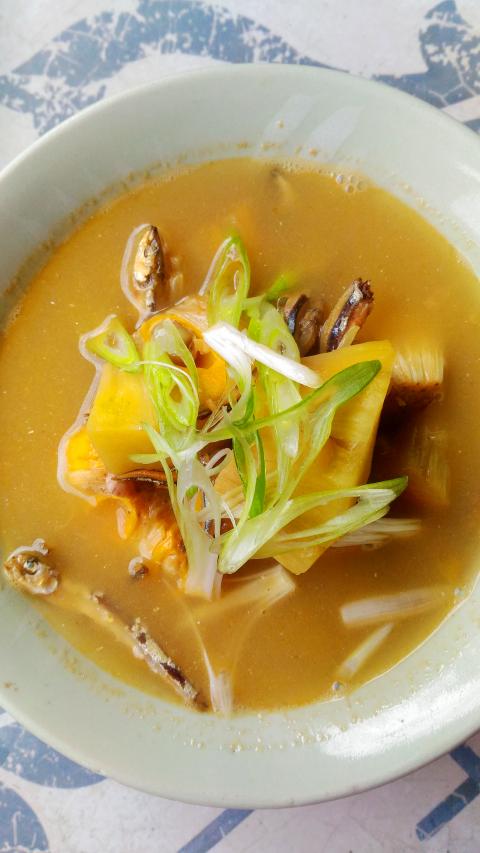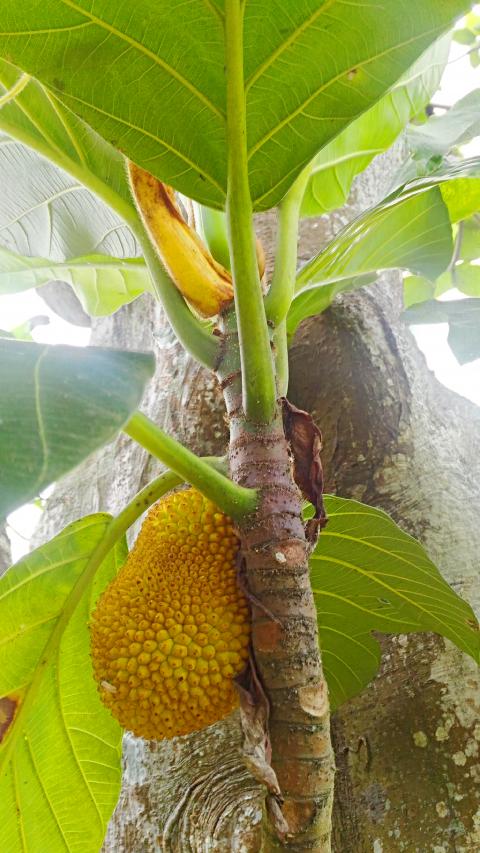The summer heat brings out a huge crop of breadfruit on the two old trees outside our home in Hualien. It has been doing that every year since we came here, and probably long before, but it has always been something of a conundrum what to do with this plethora of fruit. Sadly, for the most part, the fruit falls from the trees and gets mashed back into the earth, unharvested and unloved.
The breadfruit is in fact cherished by a few communities around the world, but by and large, despite its ease of cultivation and high yield, it has been rejected by mainstream culinary culture.
COLONIAL PAST

Photo: Ian Bartholomew
The breadfruit is native to the Pacific Islands, where it remains a popular and important staple. It was European sailors who brought it to the attention of the world, part of a failed effort to introduce it as a cheap and abundant food for slaves working the plantation of the West Indies. The slaves did not take to it and the project was abandoned, but this venture spread the cultivation of breadfruit through a wide swath of the planet.
The breadfruit’s other claim to fame, related to this colonial project, was its supporting role in the high drama of “the mutiny on the Bounty,” for the infamous Captain William Bligh was bringing a shipment of breadfruit back to England when the crew of his ship, the HMS Bounty, mutinied and cast the captain and a small number of loyal officers and men adrift in an open boat. This event is the subject of five films dating back to 1916 and most recently in the 1984 film The Bounty with Mel Gibson and Anthony Hopkins.
I can find no reason for why breadfruit was rejected by the slaves of the West Indies and the project that Captain Bligh played a minor part in failed so spectacularly, unless it was simply that nobody likes food that is willfully imposed on them. Ask any small child. That said, it must be acknowledged that breadfruit does present some challenges. It is related to the mulberry and the jackfruit, and has a distinctive texture somewhere between chewing gum and custard, which can be disconcerting on first acquaintance.

Photo: Ian Bartholomew
Quite apart from those areas in which breadfruit has established itself, it also won praised from its early European discoverers. The naturalist Alfred Wallace, writing in the mid-19th century, compared the flesh of roasted breadfruit to Yorkshire pudding, adding that his assistant had thought it like mashed potatoes and milk. He summed up his appraisal saying that its flavor “like good bread and potatoes” is one you never get tired of. High praise indeed, but such encomiums have done nothing for breadfruit’s popularity in western cuisine.
FINICKY FRUIT
My own experience is that breadfruit has many outstanding qualities, with the major drawback of its being the unpleasant process of removing the skin. The raw fruit secretes a viscus glue-like mucous which sticks to everything it touches, and inconvenient preventative measures are required to get past this first step of its preparation.
The use of disposable gloves is highly recommended, and there are various methods of preventing the knife from becoming inconveniently sticky. Employing a scraper to keep the knife clean, working under running water or even using a heated blade, are all methods I have encountered, but the best is to get it pre-processed. In Hualien we are lucky as most traditional markets have a section dedicated to stalls catering to the Aboriginal community, and during the season, purchasing a bag of cleaned breadfruit is no harder than handing over the admittedly high price of NT$100 for a plastic bag filled with ready-to-use fruit.
Assuming you’ve got your breadfruit, already prepared, what are you supposed to do with it? Taiwanese who grew up in the countryside, particularly on the east coast, will often wax lyrical about breadfruit soup or deep fried breadfruit crisps, but mostly as a nostalgic lament for something that is no longer available. This is definitely grandma food, and while it may be the stuff of fond childhood memories for some, it has failed to become popular with the culinary mainstream. In 2013 FTV did a report promoting breadfruit, but only as a substitute to make up for the lack of affordable “normal” vegetables following a succession of typhoons.
The trees outside our house are old and have suffered from considerable neglect, but even the very slight care that we have given them has been effective in restoring them to great vigor. The tree is notable for its extraordinary fecundity, and despite being widely grown in Hualien, it is not widely utilized as a food source outside the local Aboriginal communities. It is troublesome to harvest, requiring long handled nets with a fitted cutting blade, quite apart from the difficulty of preparation already mentioned. Lots of people suggest that it should be eaten, but it is not nearly as widely used as its ubiquity might suggest.
While there are many cultivars of breadfruit, it is broadly divided into two categories: seedless and seeded. The variety with seeds is the more common in Taiwan, and the seeds can be cooked and eaten, with a wide consensus that they taste like peanuts. Despite this appealing flavor, the seeds are not widely eaten in Taiwan. To be eaten, the seeds should be cooked separately from the flesh. The flesh generally needs only a very short cooking time, while the seeds need a bit longer before releasing their full flavor potential.
MOSQUITO REPELLENT
In the Hualien countryside, many people also burn dried clusters of the breadfruit flowers, known as “male inflorescences,” as a cheap and effective mosquito repellent. Scientists with USDA’s Agricultural Research Service have found that breadfruit flowers contain three chemicals — capric acid, undecanoic acid and lauric acid — that work wonderfully for repelling flying insects, including mosquitoes (www.usda.gov/media/blog/2013/11/19/breadfruit-bad-news-mosquitoes). Keeping the flower cluster burning does require a little fiddling about, but like the fruit itself, these clusters are profuse anywhere there is a breadfruit tree.
Nutritionally, breadfruit is packed with good things and on more than one occasion, has been thought of as a solution to world hunger. It is incredibly robust in hot, humid climates that can often decimate more fragile mainstream fruit and vegetables. Carbohydrates make up a significant portion of its calories, and these convert to various types of sugar as ripens, making breadfruit as suited to sweet as to savory preparations. It is not notable for the extent of its vitamin content, but like many tropical fruits are rich in those of the B-complex group.
Why breadfruit, with all its advantages, has not become a more important food source is one of those mysteries that continue to bewilder in a world that faces ongoing problems with food scarcity. It presents challenges both in harvesting and preparation, but I cannot help but feel that it has potential to play a bigger part in culinary culture.
Breadfruit soup with dried whitebait
Recipe (serves four)
This is the default recipe for breadfruit in Taiwan and can occasionally be found at Aboriginal restaurants, particularly along the east coast, but it is far from being the only preparation. My own experience remains somewhat limited, but I have had good results including breadfruit with pork rib soup, and have tasted battered and deep fried breadfruit, which is excellent accompaniment to seafood. This preparation is about as simple as cooking can get, but shows how breadfruit is really easy to use once you get beyond the initial processing.
Ingredients
300g cleaned breadfruit, cut into chunks
30g dried whitebait
1 tbsp neutral cooking oil
water
1 stem scallions
Directions
1. Add oil to pot over medium heat. Toss in the dried fish and cook for a couple of minutes until fragrant.
2. Add the breadfruit and fry for one or two minutes until the breadfruit is well coated with oil.
3. Add enough water to cover the breadfruit and bring to a boil. Simmer for 10 minutes until the breadfruit is soft but retains its shape.
4. Serve with finely sliced scallions.
Ian Bartholomew runs Ian’s Table, a small guesthouse in Hualien. He has lived in Taiwan for many years writing about the food scene and has decided that until you look at farming, you know nothing about the food you eat. He can be contacted at Hualien202@gmail.com.

As we live longer, our risk of cognitive impairment is increasing. How can we delay the onset of symptoms? Do we have to give up every indulgence or can small changes make a difference? We asked neurologists for tips on how to keep our brains healthy for life. TAKE CARE OF YOUR HEALTH “All of the sensible things that apply to bodily health apply to brain health,” says Suzanne O’Sullivan, a consultant in neurology at the National Hospital for Neurology and Neurosurgery in London, and the author of The Age of Diagnosis. “When you’re 20, you can get away with absolute

When the South Vietnamese capital of Saigon fell to the North Vietnamese forces 50 years ago this week, it prompted a mass exodus of some 2 million people — hundreds of thousands fleeing perilously on small boats across open water to escape the communist regime. Many ultimately settled in Southern California’s Orange County in an area now known as “Little Saigon,” not far from Marine Corps Base Camp Pendleton, where the first refugees were airlifted upon reaching the US. The diaspora now also has significant populations in Virginia, Texas and Washington state, as well as in countries including France and Australia.

On April 17, Chinese Nationalist Party (KMT) Chairman Eric Chu (朱立倫) launched a bold campaign to revive and revitalize the KMT base by calling for an impromptu rally at the Taipei prosecutor’s offices to protest recent arrests of KMT recall campaigners over allegations of forgery and fraud involving signatures of dead voters. The protest had no time to apply for permits and was illegal, but that played into the sense of opposition grievance at alleged weaponization of the judiciary by the Democratic Progressive Party (DPP) to “annihilate” the opposition parties. Blamed for faltering recall campaigns and faced with a KMT chair

A police station in the historic sailors’ quarter of the Belgian port of Antwerp is surrounded by sex workers’ neon-lit red-light windows. The station in the Villa Tinto complex is a symbol of the push to make sex work safer in Belgium, which boasts some of Europe’s most liberal laws — although there are still widespread abuses and exploitation. Since December, Belgium’s sex workers can access legal protections and labor rights, such as paid leave, like any other profession. They welcome the changes. “I’m not a victim, I chose to work here and I like what I’m doing,” said Kiana, 32, as she